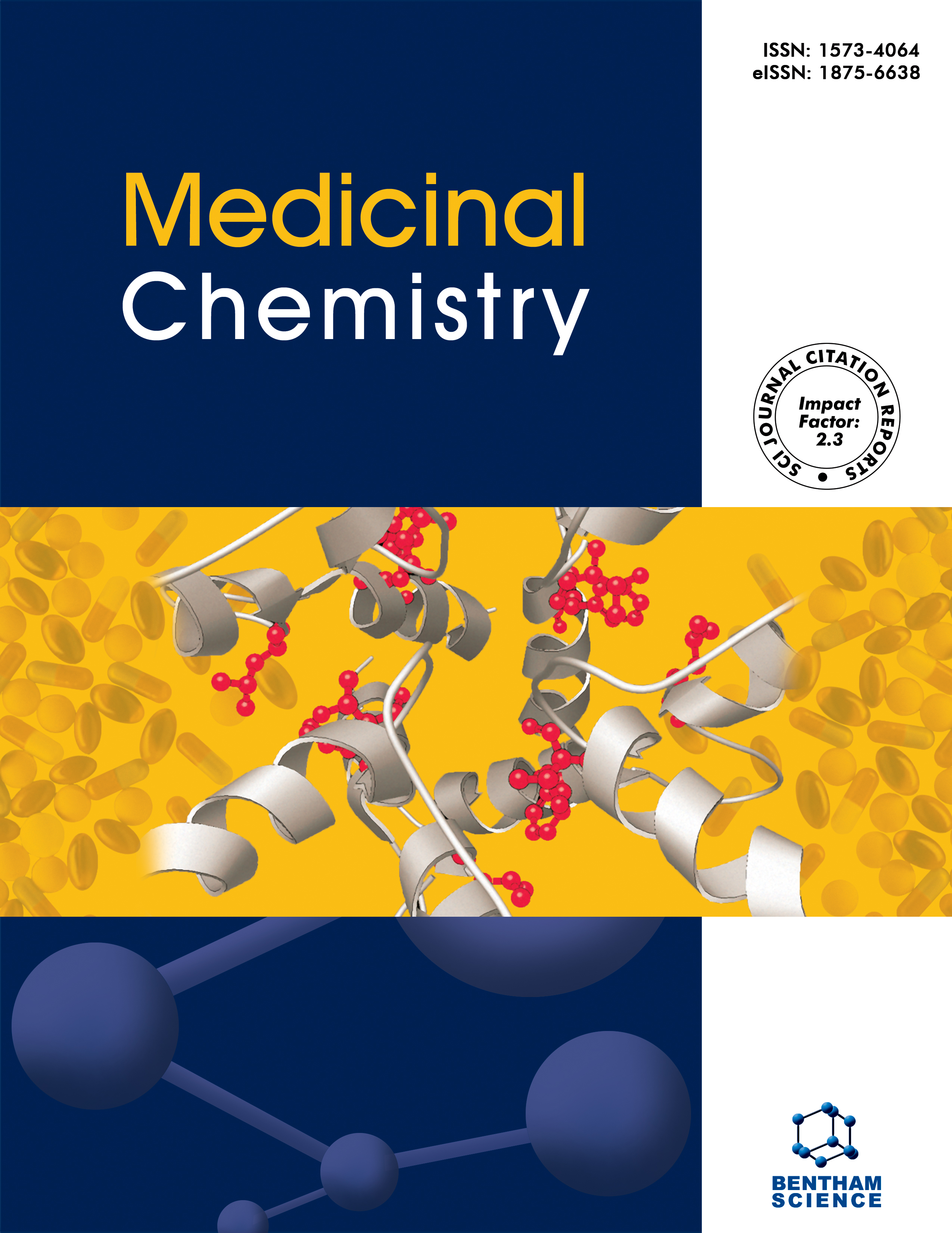- Home
- A-Z Publications
- Medicinal Chemistry
- Previous Issues
- Volume 10, Issue 6, 2014
Medicinal Chemistry - Volume 10, Issue 6, 2014
Volume 10, Issue 6, 2014
-
-
Essential Structural Features of Novel Antischizophrenic Drugs: A Review
More LessDue to the wide range of chemical structures and variety of mechanisms of action of antischizophrenic agents, it is difficult to identify and confirm a common pharmacophore. The present review summarizes various pharmacophore models for antischizophrenic activity including those based on the new targets, the kynurenine aminotransferase (KATs), which may facilitate the development of novel drugs. Some models illustrate t Read More
-
-
-
Potential Therapeutic Agents from the Red Sea Organisms
More LessIn the last few decades, the pharmaceutical application of marine natural products has attracted much attention from both organic and medicinal chemists. Recently, significant interest is focused on the isolation, identification, and biological activities of compounds from the Red Sea organisms and many of these compounds show promising biological activities, particularly cytotoxic and antimicrobial effects. This review covers th Read More
-
-
-
Effect of 9-hydroxy-α- and 7-hydroxy-β-pyran Naphthoquinones on Trypanosoma cruzi and Structure-activity Relationship Studies
More LessThe available treatment for the prevention and cure of Chagas disease, caused by the protozoan Trypanosoma cruzi, is still unsatisfactory. Thus, there is an urgent need to develop new drugs. In the last few years, our research group has focused on finding a new chemical entity able to target the infectious bloodstream trypomastigotes. In this study, we assayed 16 β-lapachone analogous with modifications in the pyran and aro Read More
-
-
-
Antiproliferative Evaluation of N-sulfonyl-2-alkyl-six Membered Azacycles. A QSAR Study
More LessA series of functionalized N-sulfonyl-piperidines and N-sulfonyl-tetrahydropyridines were evaluated for their antiproliferative activity against the representative panel of human solid tumor cells A2780 (ovarian), SW1573 (non-small cell lung) and WiDr (colon). The SAR study showed for WiDr cells a correlation between the biological activity and the length of the N-sulfonyl group, the nature of the substituents and the type of al Read More
-
-
-
Synthesis, Activity, and QSAR Studies of Tryptamine Derivatives on Third-instar Larvae of Aedes Aegypti Linn
More LessSpecial attention has been given to the mosquito Aedes aegypti Linn. (Diptera: Culicidae) owing to numerous dengue epidemic outbreaks worldwide. Failure to control vector spreading is accounted for unorganized urban growth and resistance to larvicides and insecticides. Therefore, researchers are currently searching for new and more efficient larvicides and insecticides to aid dengue control measures. Triptamine is Read More
-
-
-
Discovery of Novel Lead in the Group of N-substituted Piperazine Ether Derivatives with Potential Histamine H3 Receptor Activity
More LessThe search for novel lead from the group of various substituted N-piperazine ether derivatives was performed. Acyl- and pyridylpiperazine ethyl/propyl ethers were obtained via three different synthetic pathways. Affinity to histamine H3 receptor was established, as well as, for selected compounds, selectivity towards histamine H4R. Docking studies to the histamine H3R homology model strengthened the position of (4-(3 Read More
-
-
-
Synthesis, In Vitro Biological Screening and Molecular Docking Studies of Novel Camphor-Based Thiazoles
More LessSynthesis, characterization and investigation of antibacterial and antifungal activities of twelve camphor based 2,4-disubstituted 1,3-thiazoles is presented. Their structures were determined using NMR, IR, FAB MS and HRMS analyses. Among the derivatives, 3i and 5 were found to exhibit antifungal and antibacterial activities comparable to that of fluconazole and ciprofloxacin against yeast belonging to Candida spp., MIC 0 Read More
-
-
-
Synthesis of Novel 2,3,4-trisubstituted-oxazolidine Derivatives and In Vitro Cytotoxic Evaluation
More LessWe have previously reported the discovery of cytotoxic and pro-apoptotic hit compound 1,1-dimethylethyl (S)- 2,2-dimethyl-4-[(3-nitrophenoxy)methyl]-3-oxazolidinecarboxylate 1 against leukemia cells. In the present work we describe the synthesis of 25 derivatives of this hit varying the substituent at ring or stereochemistry of the oxazolidine ring and evaluated them against human cancer cells lines. Six comp Read More
-
-
-
Design, Synthesis and Cytotoxic Activity Evaluation of New Aminosubstituted Benzofurans
More LessA number of new aminosubstituted benzofuran analogues have been prepared and their cytotoxic/cytostatic activity was investigated against five human tumor cell lines (MCF-7, SKBR3, SKOV3, HCT-116 and HeLa). Certain compounds showed noticeable tumor cell growth inhibition, indicative of possible structure-activity relationships.
-
-
-
Discovery of Novel CK2 Leads by Cross-Docking Based Virtual Screening
More LessAuthors: Haopeng Sun, Xiaowen Wu, Xiaoli Xu, Zhengyu Jiang, Zongliang Liu and Qidong YouProtein kinase CK2, a serine/threonine kinase, is an attractive therapeutic target for many diseases. Here we described an application of cross-docking based drug design to discover novel and potent CK2 leads. Glide SP was chosen as the most suitable docking approach by comparing four docking protocols through native-docking. Then twenty-four CK2 crystal structures were compared by recovering known active ligands f Read More
-
Volumes & issues
-
Volume 21 (2025)
-
Volume 20 (2024)
-
Volume 19 (2023)
-
Volume 18 (2022)
-
Volume 17 (2021)
-
Volume 16 (2020)
-
Volume 15 (2019)
-
Volume 14 (2018)
-
Volume 13 (2017)
-
Volume 12 (2016)
-
Volume 11 (2015)
-
Volume 10 (2014)
-
Volume 9 (2013)
-
Volume 8 (2012)
-
Volume 7 (2011)
-
Volume 6 (2010)
-
Volume 5 (2009)
-
Volume 4 (2008)
-
Volume 3 (2007)
-
Volume 2 (2006)
-
Volume 1 (2005)
Most Read This Month
Article
content/journals/mc
Journal
10
5
false
en


